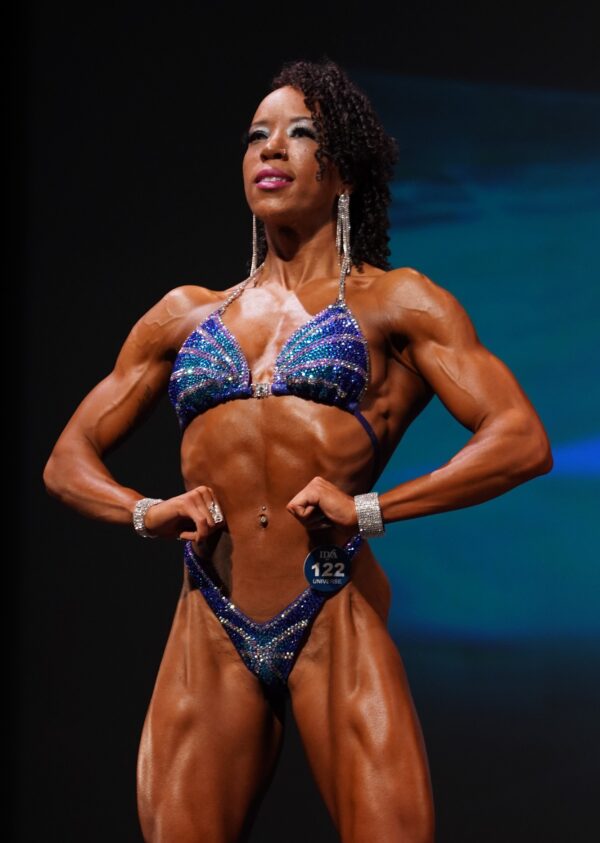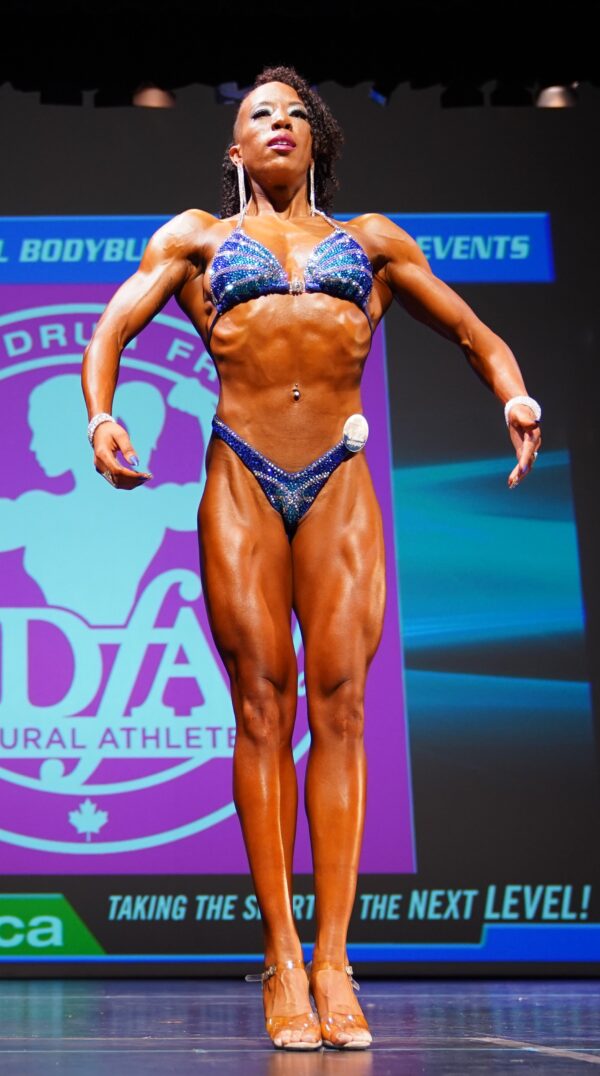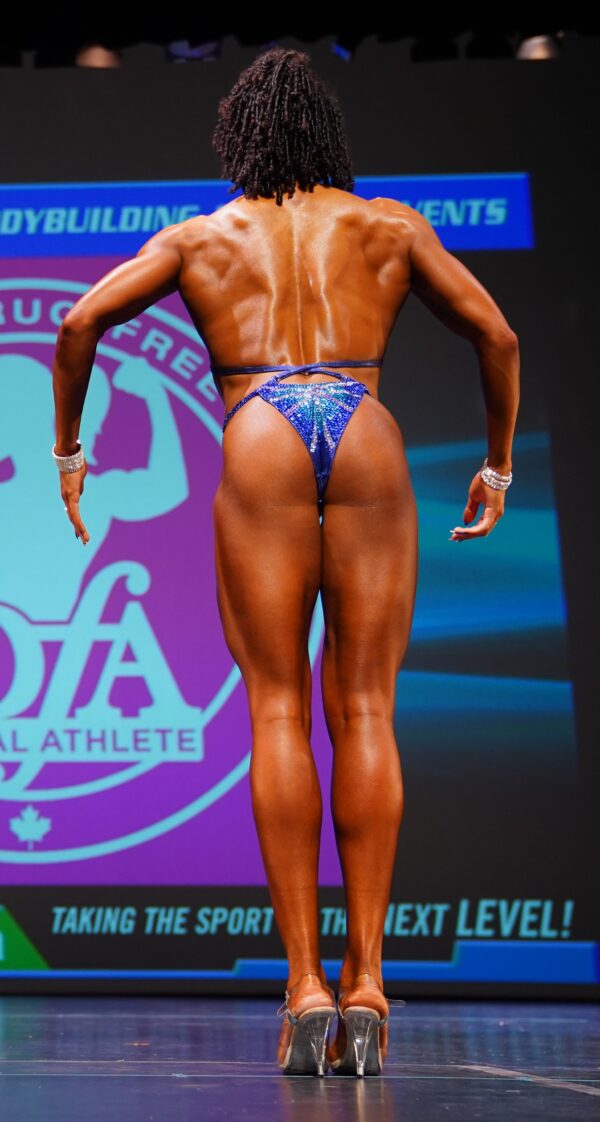This detailed breakdown of the Figure Division within the IDFA outlines everything an athlete needs to know before stepping on stage. Whether you’re a novice or a seasoned pro, understanding these guidelines is crucial for success in competition.
Is Figure for You?
 Whether you’re a first-time competitor or a seasoned athlete, the Figure division is where balance, symmetry, and poise meet. In this division, you strive to embody the pinnacle of muscularity and femininity, showcasing a physique that is both strong and elegantly proportioned. Your broad, capped shoulders with defined deltoids, tapering into a narrow waist that creates a classic V-taper, are perfectly suited for this category. Your legs, with toned and well-defined quads and hamstrings, exude both power and grace with every pose.
Whether you’re a first-time competitor or a seasoned athlete, the Figure division is where balance, symmetry, and poise meet. In this division, you strive to embody the pinnacle of muscularity and femininity, showcasing a physique that is both strong and elegantly proportioned. Your broad, capped shoulders with defined deltoids, tapering into a narrow waist that creates a classic V-taper, are perfectly suited for this category. Your legs, with toned and well-defined quads and hamstrings, exude both power and grace with every pose.
But it’s not just about physical attributes—Figure is about embodying confidence and charisma. You command the stage with a presence that captivates both the audience and judges. Your movements are fluid and precise, reflecting your dedication to perfecting your craft. The aesthetic presentation is key, with every detail meticulously polished, from your posing suit to your hair and makeup.
This is your moment to shine, to showcase the hard work and dedication that defines you as an athlete, and to inspire others with your strength and elegance.
Have questions or need more information? We’re here to help. Contact Shaun or join our Free Facebook group, IDFA Room, to connect with fellow competitors and get inspired.
Athlete Attire: What do you Wear?
Posing Suit:
- Competitors will wear a Two-piece posing suit that crosses over and attaches in the back.
- G-strings, thongs, or bottoms that are too low in the front or back are not allowed.
- Must be in good taste and approved by the IDFA prior to competition.
- Worn during both the Judging round and Presentation & Awards round.
- All suits will be checked at Athlete Registration/Check-in.
Jewellery:
- Earrings, bracelets, and wedding rings are permitted.
- Jewelry should complement your look without overpowering or distracting from your physique.
Shoes:
- Clear heels are required for both rounds.
- They can be either slip-on or with straps.
- Heel is no higher than 5″ and the sole no higher than 1.5″.
- Platform heels are not allowed.
- All shoes will be checked at Athlete Registration/Check-in.
Classes: Where do you Fit?
Novice Figure:
- Competitors who have not placed in the top 3 in an Open class equivalent in another organization or in the Novice class in an IDFA sanctioned event.
- If more than 10 competitors, there will be 2 classes divided evenly and fairly based on height.
Open Figure:
- Competitors who have placed top 3 in the Novice class in an IDFA sanctioned event or in the Open class equivalent in another organization.
- If more than 10 competitors, there will be 2 classes divided evenly and fairly based on height.
- Winners of the Open class will earn IDFA Pro Status, provided there are at least 3 athletes in the class.
Masters 40+ Figure:
- Competitor is at least 40 years of age on day of competition.
- One class for all Masters 40+ Figure competitors.
Masters 50+ Figure:
- Competitor is at least 50 years of age on day of competition.
- One class for all Masters 50+ Figure competitors.
Pro Figure:
- Competitors who hold a current IDFA Pro Card
- Competitor has earned Pro Status in a recognized natural organization and has been approved to compete in the IDFA Pro Division. The IDFA must approve this prior to competition.
- One class for all Pro Figure competitors.
Crossovers: Competing in Multiple Classes & Divisions
- Masters 40+: Competitors in the Masters 40+ class can also enter the Novice and/or Open classes.
- Masters 50+: Competitors in the Masters 50+ class have the option to enter the Novice and/or Open classes. Additionally, they can also compete in the Masters 40+ class.
- Novice Competitors: Novice competitors may be allowed to enter the Open class as well, but this requires approval by the Promoter on a show-by-show basis.
- Multiple Divisions: Athletes are allowed to enter more than one Division in the same show. For example, you can compete in both Figure and Women’s Physique, or in Men’s Bodybuilding and Men’s Classic Physique at the same event.
This flexibility allows you to showcase your physique across different divisions and classes, maximizing your competitive experience and opportunities to shine on stage.
Judging Criteria: How will you be Judged?
Judges will assess:
Muscular Development:
- Judges seek a muscular, toned feminine physique.
- Excessive muscularity is not desired, as this is not a bodybuilding competition.
- The physique should have a reasonable level of body fat that allows for clear separation between major muscle groups (e.g., biceps to triceps) without visible striations.
Symmetry and Proportion:
- No body part should stand out disproportionately.
- The physique should have an even flow, with equal development across all muscle groups.
Stage Presence:
- Judges will assess your confidence, the execution of quarter turns, and the Figure Athlete T-walk.
- Skin tone, makeup, and suit selection, as well as overall poise and presentation, are key factors.
Judging Round: What do you have to do on stage?
Competitors will:
- Line up in numerical order, facing the front in a Front Pose.
- Execute a series of mandatory poses as directed by the Head Judge.
Mandatory Poses:
Front Pose:
- Facing the audience.
- Heels are together.
- Both arms hang relaxed at the sides along the centerline of the body.
- Flare the lats to display the V-taper, with elbows slightly bent.
- Keep the tips of the fingers no further than 6 inches from the body.
Side Pose – Left
- Head faces the same direction as the body.
- Heels are together.
- The Left arm (closest to the audience) hangs relaxed and slightly back from the body’s centerline, with a slight bend at the elbow.
- The right arm hangs relaxed and slightly in front of the centerline, also with a slight bend at the elbow.
- The arm positioning creates a slight twist in the upper body, with one shoulder lowered and the other raised.
Back Pose
- Facing the back of the stage.
- Heels are together.
- Brush hair to one side to reveal the back.
- Both arms hang relaxed at the sides along the centerline of the body.
- Flare the lats to display the V-taper, with elbows slightly bent.
- Keep the tips of the fingers no further than 6 inches from the body.
Side Pose – Right
- Head faces the same direction as the body.
- Heels are together.
- The Right arm (closest to the audience) hangs relaxed and slightly back from the body’s centerline, with a slight bend at the elbow.
- The left arm hangs relaxed and slightly in front of the centerline, also with a slight bend at the elbow.
- The arm positioning creates a slight twist in the upper body, with one shoulder lowered and the other raised.
Presentation & Awards Round
Competitors will:
- Line up in numerical order, on the back line, facing the audience in a Front Pose (either hand on hip).
- Each competitor will be introduced for their Athlete T-walk.
- Figure Athlete T-walk: Once the competitor is introduced they will walk in front (and Center) of the line-up, complete a Front Pose, then walk towards the front of the stage (Front Center), complete a Front Pose and Back Pose, then head to their left to the far end of the stage (Stage Right), complete either a Front Pose or a Side Pose, then head to the far right of the stage (Stage Left), complete a Front Pose or Side Pose, and then return to their original position in the line-up.
- This is an Athlete T-walk and not a posing routine. The poses will be Figure poses, not bodybuilding style poses.
- The Athlete T-walk should take about 30 seconds per competitor, providing an opportunity to display your physique and confidence to the judges and audience.
Awards Presentation:
After the presentation round for each competitor in the class is completed:
- All competitors in the class will exit the stage behind the curtain. If there are 5 or fewer competitors in the class, they will remain on stage.
- The top 5 competitors will be called back to the stage, in no particular order, to the back line. Awards will be handed out to the top 5 on stage during the show. Note: Every athlete in the class will get an official placing on the IDFA website after the show.
- The awards presenter will place a medallion around your neck as you line up on the front line of the stage. Competitors will be arranged in order from 5th to 1st place. The top 5 placements will be officially announced on stage.
- After the awards are handed out, a photo will be taken of the Top 5, then the Top 3, and finally, a solo photo with the Winner.
- Note: For the Pro Classes we will Official place every one of them on the stage at the event. For example, if we have 8 Pro competitors, we will place them 8th to 1st place at the show with medallions.
Award Details:
- Amateur: The Top 3 will receive Large IDFA Custom Medallions, while 4th and 5th place will receive smaller IDFA medallions.
- Pro: The Top 10 will receive Large IDFA Custom Medallions. Cash prizes may be awarded, and these will be announced prior to the event.
This is the process for awarding competitors in all classes, ensuring a clear and organized presentation.
JUDGING – ONLINE COMPETITIONS
Submitted Competitor Photos and Videos will be compared against the Photos and Videos of the other competitors in your class. Official IDFA Judges will be individually and privately going over all of the competitor Photos and Videos and comparing them and ranking them from 1st place to the final placing and submitting them to the IDFA as their official placings just as we do at our Live Competitions. All competitors will be placed.
PHOTOS and VIDEO SUBMISSIONS – ONLINE COMPETITIONS
We will need a photo of each mandatory pose. We will also need a VIDEO of you performing all the mandatory poses.
For the Photos and Video make sure we see your entire body from the bottom of your foot to the top of your head. You can not edit or use filters on the Photos and Video. For the Video, if you are using your phone, hold it upright (or vertically). We will be putting together a Contest Coverage and Results video for every online competition.
To validate the date we will need one photo of you holding a piece of paper with the code word on it. We will be emailing the code word out to all the athletes late the evening before the online competition.
Send your Photos and Videos submissions to info@idfa.ca. We can also use sending files sites such as DropBox, Wetransfer, etc. If you prefer another method for sending Photos and Videos please email Shaun at info@idfa.ca. The main file sharing programs we use are Dropbox and WeTransfer.
If you have any questions please message Shaun at info@idfa.ca.
This comprehensive guide ensures that you’re fully prepared for every aspect of the competition, from attire to posing and judging criteria. Whether you’re just starting or aiming for the Pro division, this information will help you present your best self on stage.




















